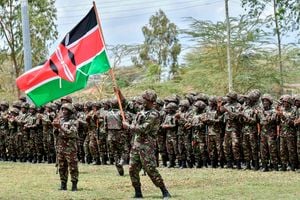Checks enhanced to keep sleeping sickness at bay

A tsetse fly craws on a piece of wood in Mt Kenya Forest.
The Kenya Tsetse and Trypanosomiasis Eradication Council (Kenttec) has heightened surveillance in 38 counties after sporadic cases along the Uganda border.
Though the last case of human African trypanosomiasis (sleeping sickness or nagana) was reported in Busia County in 2012, several cases have since been reported around Lake Victoria and in Turkana County.
Kenttec Chairman Robert Monda said they feared a recurrence of sleeping sickness since it was a transboundary disease. It’s for this reason they’re conducting periodic monitoring to ensure it’s kept at bay.
Dr Monda was speaking at Kalankware Primary School in Igembe Central, Meru County, where the state corporation under the Ministry of Agriculture handed over a borehole drilling site.
The council, Dr Monda said, was also keen on ensuring domestic animals in tsetse fly infested areas such as near national parks and game reserves were regularly sprayed to repulse the insects.
Food insecurity
Tsetse flies are a major problem that affects wildlife, livestock and crop production, contributing to food insecurity. Failure to treat livestock early enough could see them succumb to the disease.
The flies also cause serious economic damage, especially in the tourism sector, since they are prevalent in game reserves and national parks, depleting wildlife.
Global warming could see tsetse-infested areas expanding.
To mitigate this, Kenttec has set up tsetse fly traps in affected areas and spraying livestock.
The council is also drilling boreholes in the 38 counties to discourage livestock herders from taking their animals to areas with high tsetse infestation.
Livestock farmers practicing zero grazing have also received protective nets, which prevent tsetse flies from reaching the animals.
During the dry spell, Kenttec sprayed animals in the drought-hit areas, the Nation learnt.
Dr Monda appealed to county governments in affected areas to chip in to ensure tsetse eradication.
The most affected areas are Meru National Park, Mwea Game Reserve, Kwale, Kilifi, Lamu, Tsavo, Taita Taveta, and Narok. Counties near Lake Victoria have reported sporadic cases of sleeping sickness.
Improved breeds
“We are happy Meru doesn’t have sleeping sickness, and we are working to ensure it doesn’t emerge as we are seeing in other areas. We want to be on the safe side. We don’t want to start handling human trypanosomiasis,” Dr Monda said.
The official said that once the tsetse flies problem is eradicated, the boreholes would help in the rearing of improved breeds of livestock that offer better returns.





